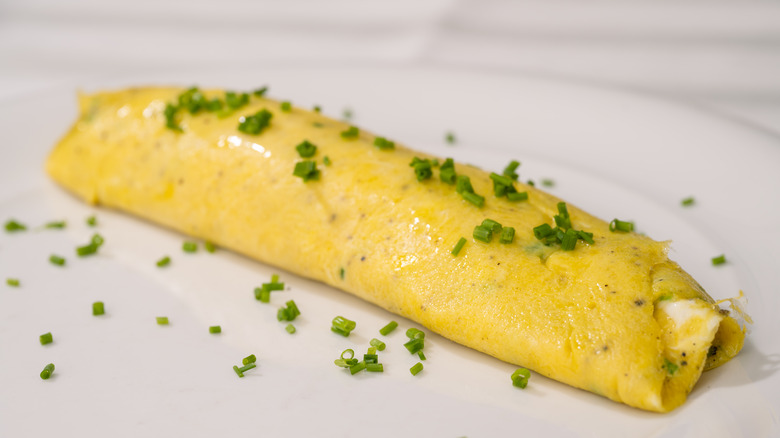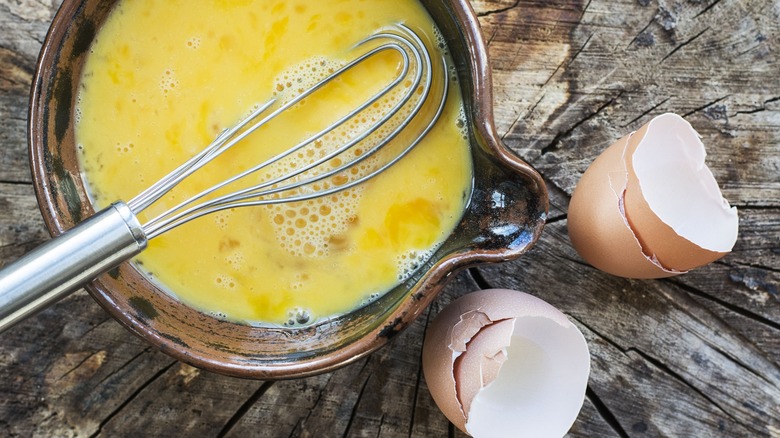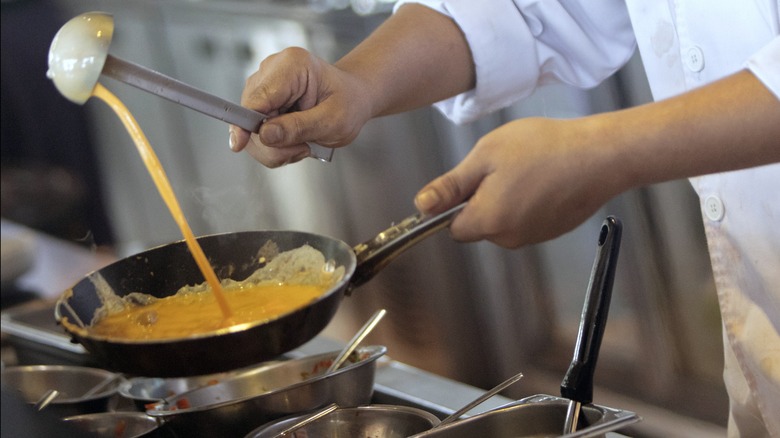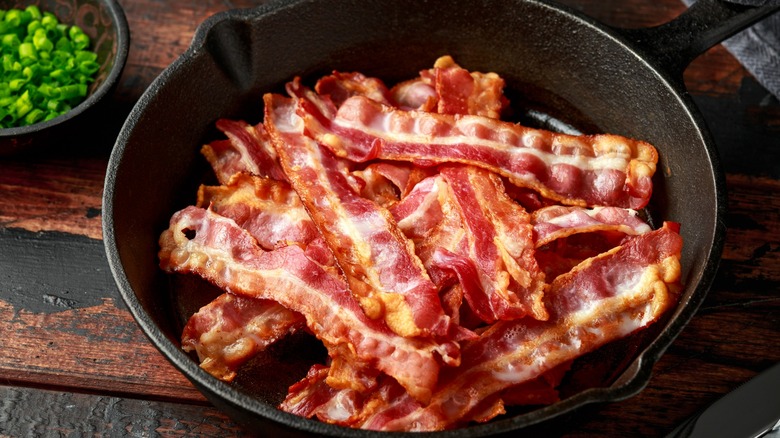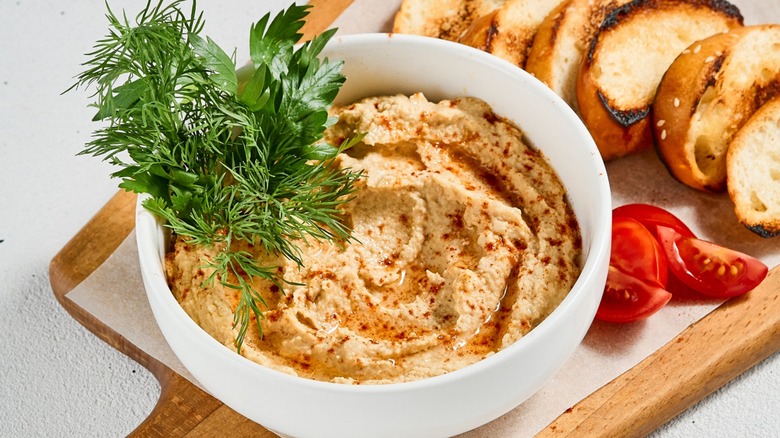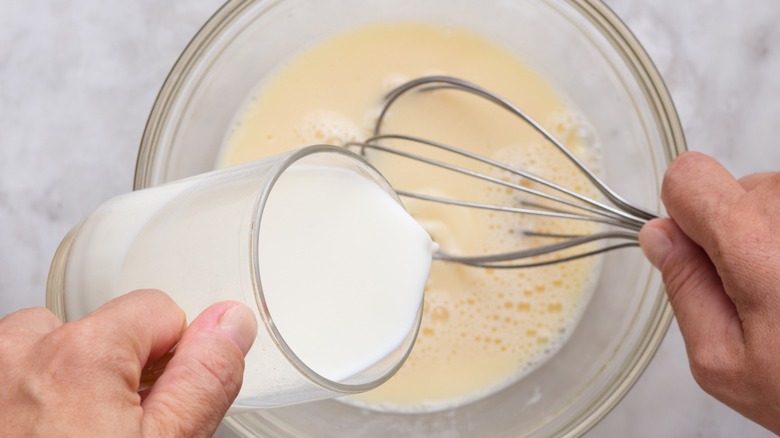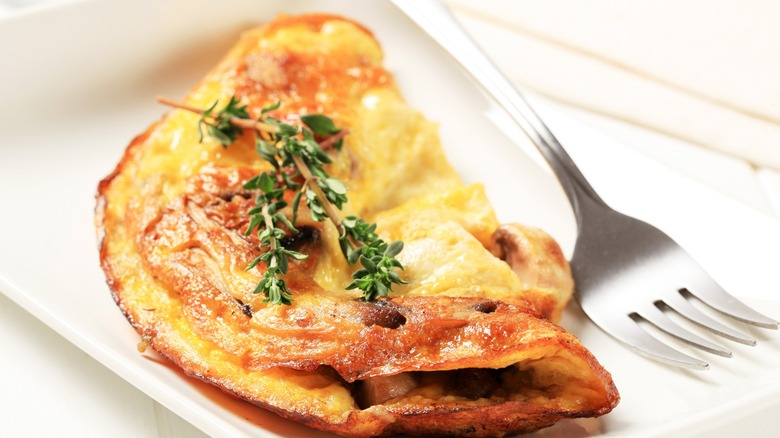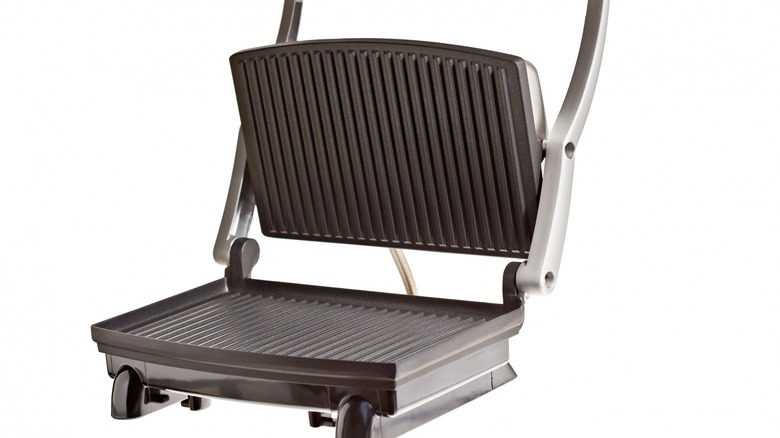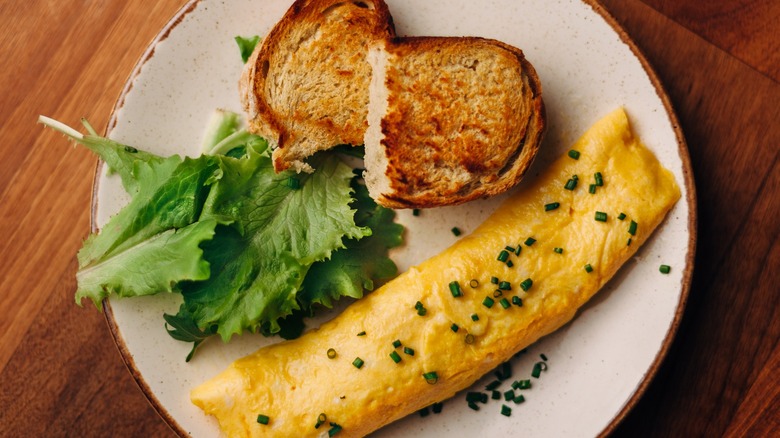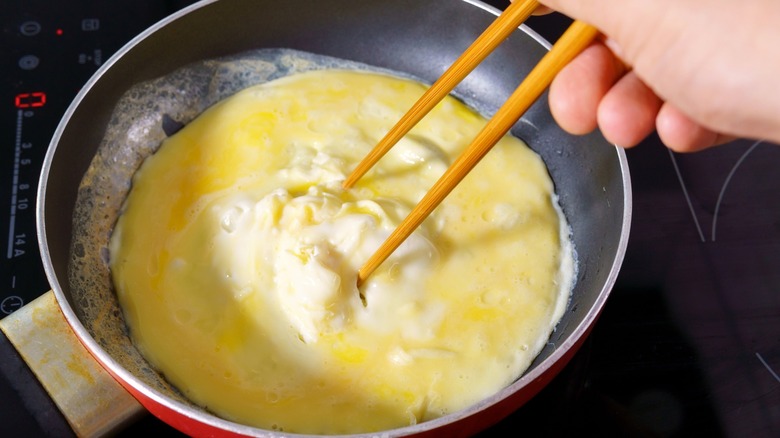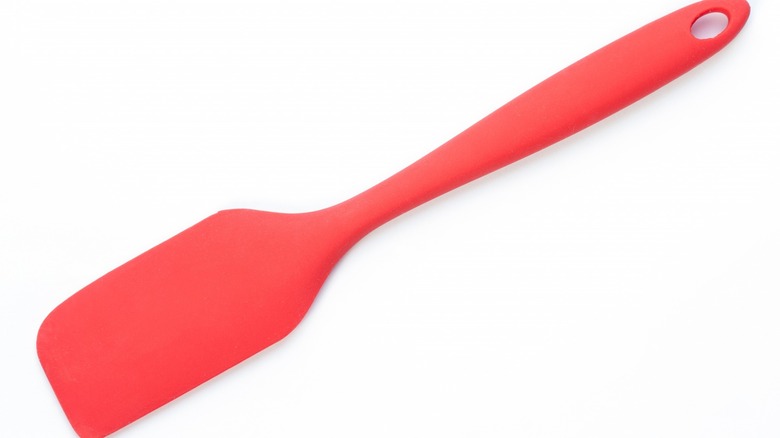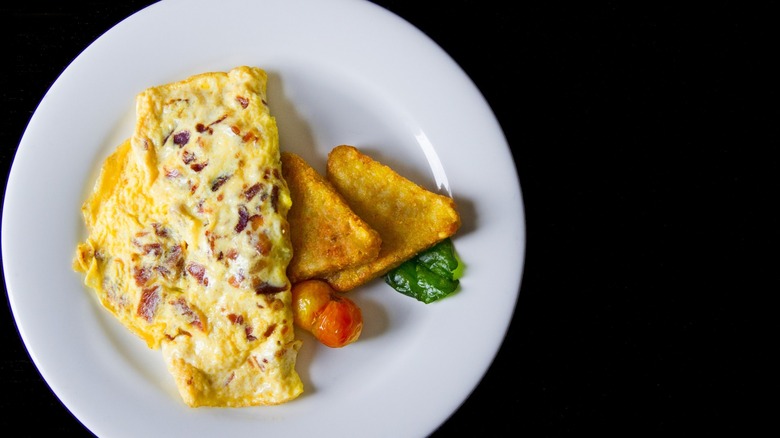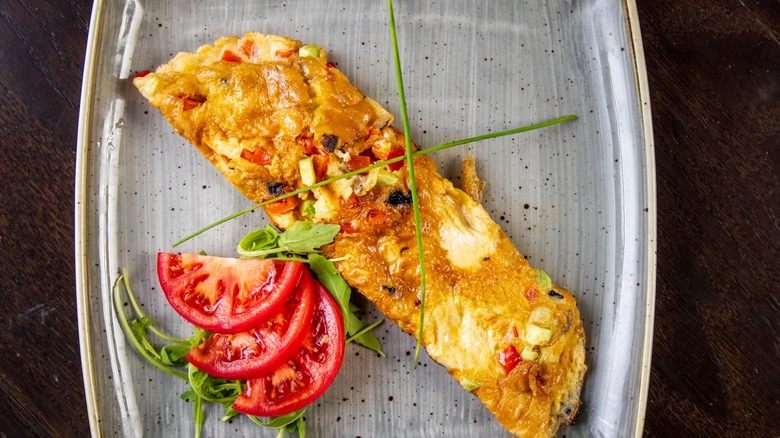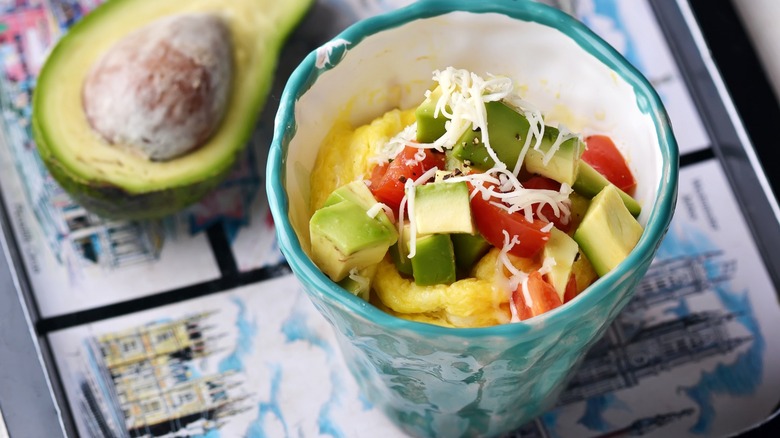15 Omelet Hacks You Should Start Using
Omelets can come together quickly, be wonderfully nutritious, and are downright delicious. They transcend the typical delineation of meals, making an ideal breakfast, lunch, or dinner entrée anytime a filling fix is required. In short, they're something of a godsend when it comes to homemade kitchen prep.
Eggs, the main ingredient of most garden-variety basic omelets, are low-calorie and packed with vitamins, minerals, and healthy fats. Combine that mixture with cooked vegetables, leafy greens, and a bit of avocado, and the wholesome nutritional value is amplified.
But let's be real: Making a perfect omelet takes practice. You need to avoid folding your omelet until all the raw egg is cooked, you need to practice your hand at a perfect flip, and you need to play close attention to your add-ons. For every trouble you've faced when cooking a 3-egg omelet, here are some ideal hacks to make life easier.
Add water to the egg mixture
Omelets and scrambled eggs have some similarities in preparation when it comes to ingredients and the beating method. After cracking a few into a bowl, beat the yolks into the whites until reaching a smooth consistency ready for a hot pan. Little streaks of egg white are a no-no, so be sure to whip them good.
A key decision is deciding what to use to mix the eggs. Some choose a dash of heavy cream, while others claim whole milk yields the fluffiest eggs. But have you considered that water might be the best mixture for scrambled eggs and omelets?
Water works best because it steams the eggs while they are cooking in the hot pan. This results in fluffy eggs that don't overcook into an unpleasant, rubbery texture. About a tablespoon for every two eggs should be plenty, so don't overdo it when adding in that splash.
Use an electric mixer for big batches
If you find yourself serving omelets during brunch, or are making breakfast for dinner for your family, consider big batches. Instead of wasting your time cracking two or three eggs at a time and pouring them into a pan to make as single orders, you'll appreciate having a "production" mindset instead.
Crack all your eggs at once, watching for any little shell pieces that need to be fished out. Then, pull out your handy dandy electric beater and get to work. This is the way things are typically done in diners, making for a smooth, volume-friendly method for preparing egg mixtures for scrambles and omelets. Don't forget the water, as it makes a big difference in consistency. Beat the eggs for a few minutes, until you reach a smooth consistency and a pale yellow hue. From there, you will need to grab a ladle.
Ladles make evenly measured omelets
If you are making more than a few omelets, a great tool is a soup ladle. It helps measure omelets while ensuring your guests all get served the same portion.
It's important to note that not all ladles are sized the same, so you'll need to select the correct size depending on how large you want your omelets to be. For baby omelets cooked in a small frying pan, a two or three-ounce ladle should suffice.
If you want to serve large, three-egg omelets, you will need to reach for a larger server. Most ladles in household kitchens hold about six ounces, so that should do the trick. If you don't have a ladle, consider measuring your raw eggs with a dry measuring cup instead. Coffee mugs and tea cups also work in a pinch, but that's where things can start to get a little messy.
Pre-cook (most) fillings ahead of time
When your mouth is watering, few things are as frustrating as biting into a yummy omelet that has raw, chewy bacon or crunchy onions and peppers within. It displeases the palate as few other breakfast tragedies can. Do yourself (and the others joining you for breakfast) a favor and pre-cook most of the fillings before adding them to your omelet to make sure it doesn't happen to you. The key word here is "most" because, obviously, there are a few caveats.
Cheese doesn't need to be warmed up, for instance, because the hot cooked eggs will do all the work for you. Adding fresh spinach, avocado, and tomatoes is fine, as well, because they add an earthy touch to the breakfast without turning to mush. Finally, herbs like basil, chives, and parsley don't need any kind of advance prep work.
As for meats like breakfast sausage, ham, and bacon, always cook them before combining with your eggs. Those eggs will cook faster than any meat will, so don't make the mistake of throwing in cold or raw meats. The same thing goes for veggies like mushrooms, onions, and peppers; cook them up before mixing them in.
Avoid these fillings
Some ingredients need a little extra heat before hitting the inside of an omelet; others should be avoided altogether.
For example, while some health enthusiasts might encourage you to add ingredients like quinoa or hummus, both will result in unpalatable results. Hummus is too liquid-based for an omelet, while quinoa will give your breakfast a strange crunch that doesn't mesh well with the soft egg texture. No matter how healthy such ingredients might seem, if the end result is something no one wants to eat, such benefits will go unrealized.
Some recipes call for the addition of apples — and while that might sound lovely in the Autumn months, you'll find excess water in your pan that could ruin everything. Make sure you keep the overly wet ingredients out while keeping your fillings-to-egg ratio balanced. The last thing you want is an overstuffed omelet disaster.
If you do choose to add "wet" ingredients like tomatoes or cooked mushrooms, be sure to pat them dry with a clean kitchen towel or paper towel. Otherwise, you'll be navigating excess liquid that could significantly complicate your omelet preparation.
Add a splash of pancake batter to the mix
Here's a hack that might seem crazy at first glance, but will provide an oomph of sweet deliciousness to your breakfast omelets. Believe it or not, pancake batter is an unexpected ingredient that IHOP adds to its omelets, and for good reason.
A splash of IHOP's buttermilk and wheat batter helps the chain create soft, fluffy omelets, and it's something you can replicate at home. It also makes the omelet sweeter and even a bit more durable, thanks to the batter addition.
Next time you plan to make omelets and pancakes on the same morning, be sure to mix and match the two. From there, you can further blur the lines by adding a few slices of sausage to your omelet and even — why not? — finish it off with a drizzle of pure maple syrup. Now there's a sweet and salty combo that will make taste buds happy.
Booze them up with a little wine
There is one possible liquid ingredient that can raise the stakes in an intriguing way, and might even add a little buzz to your morning breakfast. It comes via "Shark Tank" investor Kevin O'Leary, who has been known to use both red and white wine in his omelets.
First, O'Leary cooks a few mushrooms in butter and finishes them with a chardonnay to help give them a unique flavor. Then, in goes some ham and a splash of cabernet sauvignon. The red wine introduces a darker hue, and also a unique depth of flavor.
Eggs are then added, followed by the cooked mushrooms and onions. Be sure to keep flipping for an evenly-cooked omelet, and if nothing else the end result will certainly stand out, if not impress. So, the next time you find yourself in a situation where impressing guests is of utmost importance, grab some wine and do like self-taught chef O'Leary does.
Use a panini press
Home chefs tend to focus on cracking eggs and mixing ingredients into their omelet batches, but don't forget about all the unique ways to then cook that protein-filled breakfast staple. After adding your raw eggs to a pan, flipping can be intimidating for many, so why not look for an alternative?
Your kitchen's panini press might not be something that immediately comes to mind, but it will allow you to skip the dreaded flip. That's because it's designed with two heated plates, working in conjunction to heat both sides of whatever you are cooking. Yes, even an omelet.
Alton Brown uses this method with his spinach omelet. He starts with a little bacon grease and spinach, then closes the lid for just a bit before adding his beaten eggs. In very little time, he is left with a thin omelet, which rolls just right. A little sprinkle of cheese is all you'll need from there.
Make your omelet in a bag
Some days, folks can't be bothered with whipping out kitchen tools and working to create a meal. But don't keep eggs off your list of dinner possibilities when it comes to "not cooking," because even in times like these, an omelet can be made with only a single plastic baggie.
This is a great hack for anyone who doesn't feel like cooking. Start by bringing a large pot of water to a boil. While it's heating up, crack a few eggs into a large plastic bag, close it shut, then vigorously shake it until the eggs blend well. Open the baggie back up, then add fillings and close the bag tight once more.
Once the water comes to a boil, add the bag directly to the hot water, then let it cook for about 12 minutes or so until fully cooked. Bravo, you just nailed an amateur, modified version of sous vide ... kind of.
Roll yours up like the French do
In any typical American diner, the menu reads like a greatest-hits of possible omelets. Moving beyond the Denver and the Spanish, there's always the garden omelet (offering all the veggies your heart desires) and perhaps the Irish omelet (consisting of homemade corned beef hash with cheddar cheese), among others. Americans sure do love their omelets.
But French people, too, have a fond appreciation for the breakfast staple; they just enjoy theirs in a much simpler fashion. Instead of flipping omelets in half, a French omelet is thinner and rolled, kind of like a French crepe, only without any sweet stuff.
You might be wondering how all those yummy fillings stay inside a rolled omelet. Well, they don't. French omelets typically don't have any fillings whatsoever. Butter, eggs, and sometimes freshly chopped herbs make it into the pan, and that's typically all they need. While it might sound boring to Americans, there's something to be said about the virtues of simplicity.
Whip up an omelet with pair of chopsticks
In addition to a cooking surface, there is only one tool needed to prepare a proper omelet – something to mix it with. Although it is unorthodox, this can be a simple as a set of chopsticks.
First, you'll need to make sure you have the right set of chopsticks. Don't be breaking open those throwaway wooden ones from last night's Chinese takeout; a sturdy set made for cooking makes all the difference. Start by cracking a few eggs into a bowl, then use the chopsticks to scramble them. Add a little butter to your pan, then in go the eggs.
As the bottom of the eggs cook in the pan, use the chopsticks to help break up some of those cooked eggs, allowing more heat to come through. You might come to appreciate the gentle approach of loosening up the edges of the omelet before folding it in half. When all is said and done, use those chopsticks to carefully push the omelet, sliding it onto a plate.
Use a rubber spatula to pull the sides up
Hacks are great, but for the most part, folks don't pull out the panini press for omelet making or use chopsticks on their eggs. Typically, you're operating with a regular old skillet and rubber spatula.
Keeping things simple by getting yourself a rubber scraper spatula with a thin edge. The scrapers with really thin edges work best to pick up the delicate omelet. After cracking a few eggs, whipping them up, and adding them to a hot buttered pan, you'll see how easy it is to cook the raw egg through.
Pull your pan off the heat every now and then to swirl or shake it around, ensuring a brown crust doesn't form. After returning it to the heat, gently poke around the edges with the spatula, lifting up the and tilting the pan to allow some of the raw egg to flow underneath. This will help move some of the raw egg around without worrying about the bottom of your omelet getting too crispy or overcooked.
Use steam to your advantage
If you have no interest in using a spatula to pull sides up and cook the runny egg on top, then consider using steam to your advantage. This is another great option if flipping omelets feels intimidating, or you worry about folding your omelet over with raw and runny insides.
It is as simple as adding a lid over your eggs and letting hot steam do all the work. After adding your eggs to a hot, greased skillet, let the heat take over. Once you notice your omelet start to heat up and form, turn your heat down.
Place a lid over the skillet. No need to use a skillet that comes with a fitted lid, as anything remotely close will do the trick, especially if the lid is a bit smaller than the skillet but doesn't touch the egg. The hot steam and low heat will help cook the top of your omelet while ensuring the bottom doesn't get overdone.
Shape your omelets with a towel like Bobby Flay
Culinary artists are all about presenting a plate that is both delicious to taste and appealing to the eye. So, once you feel like your omelets are spot on in the flavor category, it's time to move on to making them look as presentable as possible.
Bobby Flay has a great trick for perfectly shaping his omelets, and all you need for the job is a clean kitchen towel. This restaurant trick will help you shape a lovely omelet using your hands, along with a towel employed as a barrier to keep them safe from the heat.
The trick is simple; start by rolling an omelet into a French-style breakfast. Then, place clean kitchen linen over the top of the omelet and gently pull the uneven edges in to give it a tidied-up appearance. From there, consider topping it with fresh chives, sliced avocado, or a sprinkle of your favorite grated cheese.
Make an omelet in a mug
Sometimes the best hacks are the ones that bring food to the table in as little time as possible. When it comes to omelets, you might not consider this an option, but with a little help from your microwave and reliable coffee mug, you can have an omelet done in the snap of a finger.
While it might not be as presentable as a French rolled or classic American omelet, it's hard to not appreciate the ease that comes with this satiating fix. To make this two-minute mug omelet, grease up a mug, add eggs, a splash of water, and mix it up. Then add any other ingredients you wish to put in your omelet.
Be sure to cook those filling ingredients ahead of time. For something simple, consider adding cold ham and cheese. Cook your eggs in the microwave for about one minute, then check on the omelet. You might need to add a little more time to the cooking process. Finish yours with diced avocado or chopped herbs, then enjoy with a fork.
Consider whipping up an inside-out TikTok omelet
TikTok has gained a reputation for hosting some incredible food hacks, and the reverse or inside-out omelet trend has raised some eyebrows. It might sound intimidating, but if you're sick of the same old routine, it's a fun way to try something different.
Rather than stuffing your omelets with loads of cheese, the "inside-out" moniker comes into play by making cheese the crispy outer layer of the omelet. So, begin by grabbing a nonstick pan or a well-seasoned cast iron skillet, then coat the bottom with shredded cheddar.
Once the cheese beings to melt, add a whisked egg mixture right over the top, then add cooked fillings to the raw egg. Once the cheese and egg have cooked for a few minutes, flip your omelet — you'll be presented with a gorgeous, crispy cheese exterior already formed.
Top off your unorthodox omelet with whatever ingredients your heart desires, then enjoy the contrasting textures of this delicious breakfast hack.
